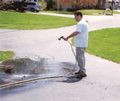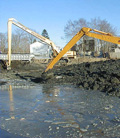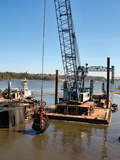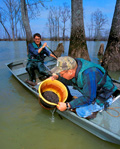Water: Contaminated Sediments
Glossary & Acronyms










"Terms of Environment" defines in non-technical language the more commonly used environmental terms appearing in EPA publications, news releases, and other Agency documents available to the general public, students, the media, and Agency employees. The definitions do not constitute the Agency's official use of terms and phrases for regulatory purposes, and nothing in this document should be construed to alter or supplant any other federal document. Official terminology may be found in the laws and related regulations as published in such sources as the Congressional Record, Federal Register, and elsewhere. Some definitions specific to contaminated sediments are listed below. EPA's master list of definitions can be found at Terms of Environment.
Glossary
- Aquatic
- living or growing in or on the water
- Benthic Environment
- the environment at the bottom of lakes, rivers, estuaries, or oceans.
- Bioaccumulation
- the process in which a substance is taken up by an aquatic organism through any route, including respiration, ingestion, or direct contact with water or sediment.
- Bioavailability
- the ability of a substance to affect organisms.
- Biodegrade
- to decompose a substance by living organisms.
- Biodiversity
- the presence of many species of organisms, plant and animal.
- Biomagnification
- the increased accumulation and concentration of a contaminant at higher levels of the food chain; organisms higher on the food chain will have larger amounts of contaminants than those lower on the food chain, because the contaminants are not eliminated or broken down into other chemicals within the organisms.
- Bulk Organics
- a class of hydrocarbon compounds including oil and grease.
- Contaminated Sediment
- soil, sand, organic matter, or minerals that accumulate on the bottom of a water body and contain toxic or hazardous materials at concentrations that may adversely affect human health or the environment.
- Dredging
- removal of material from the bottom of a water body by excavation or similar removal activity.
- Ecological
- relating to the interrelationships of organisms and their environment.
- Endangered
- referring to an endangered species; any species in danger of extinction throughout all or a significant portion of its range/habitat.
- Geologic
- referring to the history and structure of the solid portion (rocks, soils, and minerals) of the earth.
- Halogenated Hydrocarbons/Persistent Organics
- a group of chemicals that are very resistant to decay. The banned pesticide DDT and PCBs fall into this category.
- Metalloids
- metalloids are nonmetallic elements, such as arsenic and selenium, with some of the chemical properties of metals.
- Metals
- metals include elements with a metallic luster and are found on and beneath the earth's surface, such as iron, manganese, lead, cadmium, zinc, nickel, gold and mercury.
- Nonpoint Source Pollution
- pollution sources that are diffuse, without a single identifiable point of origin, including runoff from agriculture, forestry, and construction sites.
- Nutrients
- substances such as nitrogen and phosphorus compounds necessary for growth and survival. Elevated levels can cause unwanted growth of algae, and can result in the lowering of the amount of oxygen in the water when the algae die and decay.
- Point Source Pollution
- point source pollution refers to the pollution that comes from a specific, identifiable source, such as a pipe or channel.
- Pollutant
- a chemical or biological substance in a form that can be incorporated into, onto, or be ingested by aquatic organisms, consumers of aquatic organisms, or users of the aquatic environment.
- Polycyclic Aromatic Hydrocarbons (PAHs)
- a group of organic chemicals that includes several petroleum products and their derivatives.
- Sediment
- loose particles of sand, clay, silt, and other substances that settle at the bottom of a body of water. Sediment can come from the erosion of soil or from the decomposition of plants and animals. Wind, water, and ice often carry these particles great distances.
- Toxic Substance
- a substance that can cause short-term or long-term damage to biological tissue following contact or absorption. Routes of exposure of the substance include ingestion, inhalation, or assimilation into any organism, either directly from the environment or indirectly by ingestion through food chains.
- Water Column
- A hypothetical "cylinder" of water from the surface of a water body to the bottom and within which physical and chemical properties can be measured.
Acronyms
- CAA
- Clean Air Act
- CDF
- Confined Disposal Facility
- CERCLA
- Comprehensive Environmental Response Compensation and Liability Act
- CWA
- Clean Water Act
- CZMA
- Coastal Zone Management Act
- EPA
- U.S. Environmental Protection Agency
- GLCPA
- Great Lakes Critical Programs Act of 1990
- LFWA
- Listing of Fish and Wildlife Advisories
- MPRSA
- Marine Protection Research and Sanctuaries Act
- NEPA
- National Environmental Policy Act
- NOAA
- National Oceanic and Atmospheric Administration
- NSQS
- National Sediment Quality Survey
- OW
- EPA Office of Water
- USACE
- U.S. Army Corps of Engineers
- WRDA
- Water Resources Development Act
